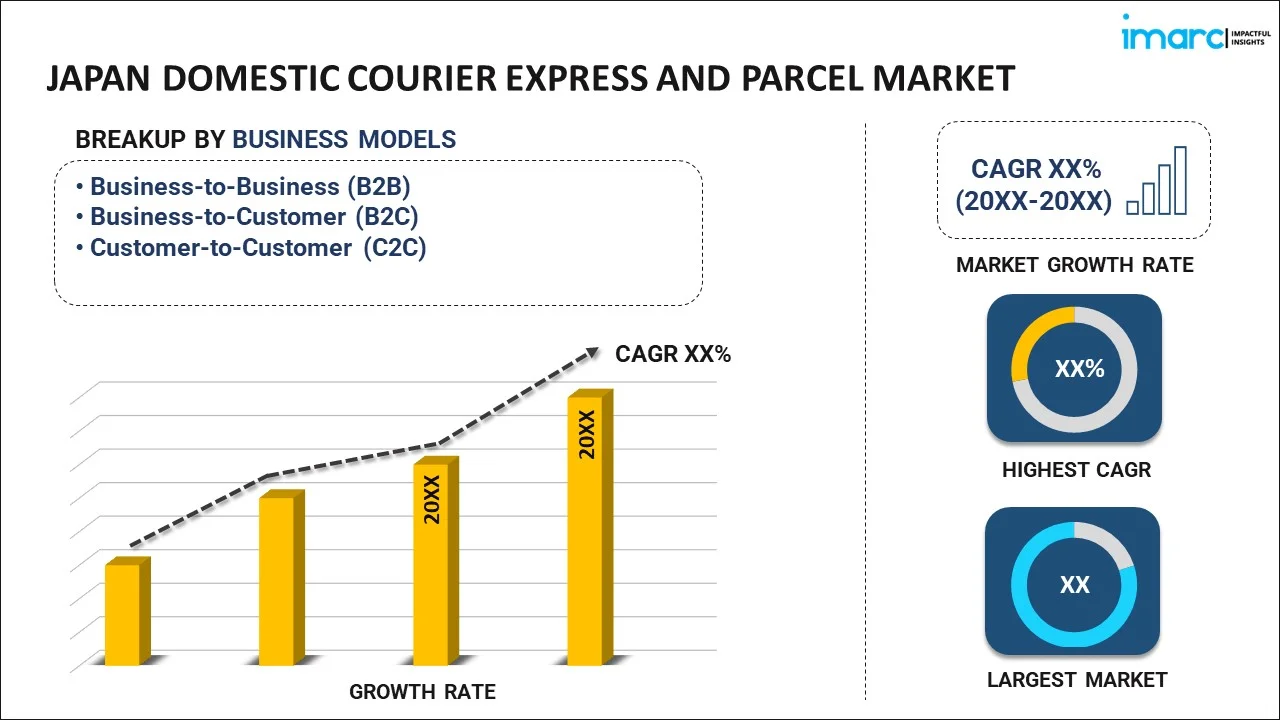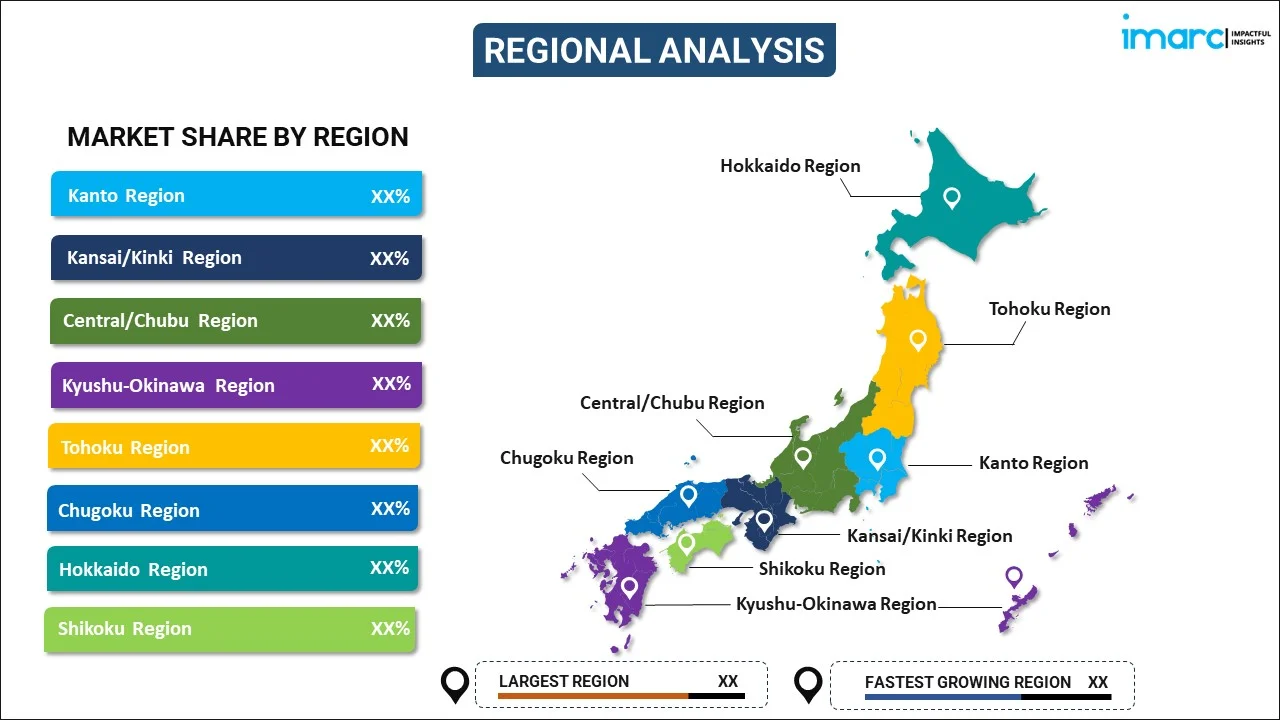
Japan Domestic Courier Express and Parcel Market Report by Business Model (Business-to-Business (B2B), Business-to-Customer (B2C), Customer-to-Customer (C2C)), Type (E-commerce, Non E-commerce), End User (Services, Wholesale and Retail Trade, Healthcare, Industrial Manufacturing, and Others), and Region 2025-2033
Market Overview:
Japan domestic courier express and parcel market size reached USD 27,050 Million in 2024. Looking forward, IMARC Group expects the market to reach USD 46,906 Million by 2033, exhibiting a growth rate (CAGR) of 6.3% during 2025-2033. The rising integration of advanced technologies, such as real-time tracking and route optimization, which enhances the service level, ensuring timely and secure deliveries is primarily driving the market growth.
|
Report Attribute
|
Key Statistics
|
|---|---|
|
Base Year
|
2024
|
|
Forecast Years
|
2025-2033
|
|
Historical Years
|
2019-2024
|
| Market Size in 2024 | USD 27,050 Million |
| Market Forecast in 2033 | USD 46,906 Million |
| Market Growth Rate 2025-2033 | 6.3% |
Domestic courier, express, and parcel (CEP) services comprise a vital segment of the logistics industry, focusing on the delivery of documents and parcels within a country’s borders. These services are known for their speed, reliability, and efficiency, ensuring the swift movement of goods from senders to recipients. The term "courier and express" typically denotes deliveries that are fast and tracked, providing real-time updates to the customers, whereas "parcel" refers to the delivery of packages, usually larger and heavier, with varying delivery timeframes. The burgeoning e-commerce sector and the escalating demand for online shopping are major drivers, propelling the need for efficient and reliable domestic CEP services. They play a pivotal role in sustaining the dynamic e-commerce environment and other sectors, which is underscored by the continual enhancements in service offerings, catering to the diversified needs of individual and business consumers.
Japan Domestic Courier Express and Parcel Market Trends:
The domestic courier, express, and parcel market in Japan is witnessing significant growth, driven by multiple factors and characterized by various evolving trends. The expansion of the e-commerce industry serves as a critical driver, intensifying the demand for efficient and reliable delivery services to cater to the rising online shopping activities. Additionally, the increasing consumer expectations for faster and real-time trackable deliveries are fueling the advancement of services in the regional market. The utilization of advanced technologies like AI, automation, and data analytics is enhancing operational efficiency, optimizing routes, and improving parcel tracking, meeting the escalating demand for swift and transparent services. The rise in the adoption of sustainable practices, such as eco-friendly vehicles and packaging solutions, is another trend reflecting the market's inclination towards environmental responsibility. Moreover, the diversification of service offerings, including same-day deliveries and time-definite services, is gaining prominence, reflecting consumer's varied needs and preferences. The continuous innovations and customized solutions are enabling service providers to maintain competitiveness and consumer relevance in the evolving market landscape. In conclusion, the synergy of technological advancements, consumer preferences, e-commerce growth, and regulatory support is sculpting the trajectory of the domestic courier, express, and parcel market in Japan, presenting opportunities for enhanced service capabilities and market development.
Japan Domestic Courier Express and Parcel Market Segmentation:
IMARC Group provides an analysis of the key trends in each segment of the market, along with forecasts at the country level for 2025-2033. Our report has categorized the market based on business model, type, and end user.
Business Model Insights:

- Business-to-Business (B2B)
- Business-to-Customer (B2C)
- Customer-to-Customer (C2C)
The report has provided a detailed breakup and analysis of the market based on the business model. This includes business-to-business (B2B), business-to-customer (B2C), and customer-to-customer (C2C).
Type Insights:
- E-commerce
- Non E-commerce
A detailed breakup and analysis of the market based on the type have also been provided in the report. This includes e-commerce and non e-commerce.
End User Insights:
- Services
- Wholesale and Retail Trade
- Healthcare
- Industrial Manufacturing
- Others
The report has provided a detailed breakup and analysis of the market based on the end user. This includes services, wholesale and retail trade, healthcare, industrial manufacturing, and others.
Regional Insights:

- Kanto Region
- Kansai/Kinki Region
- Central/ Chubu Region
- Kyushu-Okinawa Region
- Tohoku Region
- Chugoku Region
- Hokkaido Region
- Shikoku Region
The report has also provided a comprehensive analysis of all the major regional markets, which include Kanto Region, Kansai/Kinki Region, Central/ Chubu Region, Kyushu-Okinawa Region, Tohoku Region, Chugoku Region, Hokkaido Region, and Shikoku Region.
Competitive Landscape:
The market research report has also provided a comprehensive analysis of the competitive landscape in the market. Competitive analysis such as market structure, key player positioning, top winning strategies, competitive dashboard, and company evaluation quadrant has been covered in the report. Also, detailed profiles of all major companies have been provided.
Japan Domestic Courier Express and Parcel Market Report Coverage:
| Report Features | Details |
|---|---|
| Base Year of the Analysis | 2024 |
| Historical Period | 2019-2024 |
| Forecast Period | 2025-2033 |
| Units | Million USD |
| Scope of the Report | Exploration of Historical and Forecast Trends, Industry Catalysts and Challenges, Segment-Wise Historical and Predictive Market Assessment:
|
| Business Models Covered | Business-to-Business (B2B), Business-to-Customer (B2C), Customer-to-Customer (C2C) |
| Types Covered | E-commerce, Non E-commerce |
| End Users Covered | Services, Wholesale and Retail Trade, Healthcare, Industrial Manufacturing, Others |
| Regions Covered | Kanto Region, Kansai/Kinki Region, Central/ Chubu Region, Kyushu-Okinawa Region, Tohoku Region, Chugoku Region, Hokkaido Region, Shikoku Region |
| Customization Scope | 10% Free Customization |
| Post-Sale Analyst Support | 10-12 Weeks |
| Delivery Format | PDF and Excel through Email (We can also provide the editable version of the report in PPT/Word format on special request) |
Key Questions Answered in This Report:
- How has the Japan domestic courier express and parcel market performed so far and how will it perform in the coming years?
- What has been the impact of COVID-19 on the Japan domestic courier express and parcel market?
- What is the breakup of the Japan domestic courier express and parcel market on the basis of business model?
- What is the breakup of the Japan domestic courier express and parcel market on the basis of type?
- What is the breakup of the Japan domestic courier express and parcel market on the basis of end user?
- What are the various stages in the value chain of the Japan domestic courier express and parcel market?
- What are the key driving factors and challenges in the Japan domestic courier express and parcel?
- What is the structure of the Japan domestic courier express and parcel market and who are the key players?
- What is the degree of competition in the Japan domestic courier express and parcel market?
Key Benefits for Stakeholders:
- IMARC’s industry report offers a comprehensive quantitative analysis of various market segments, historical and current market trends, market forecasts, and dynamics of the Japan domestic courier express and parcel market from 2019-2033.
- The research report provides the latest information on the market drivers, challenges, and opportunities in the Japan domestic courier express and parcel market.
- Porter's five forces analysis assist stakeholders in assessing the impact of new entrants, competitive rivalry, supplier power, buyer power, and the threat of substitution. It helps stakeholders to analyze the level of competition within the Japan domestic courier express and parcel industry and its attractiveness.
- Competitive landscape allows stakeholders to understand their competitive environment and provides an insight into the current positions of key players in the market.
Need more help?
- Speak to our experienced analysts for insights on the current market scenarios.
- Include additional segments and countries to customize the report as per your requirement.
- Gain an unparalleled competitive advantage in your domain by understanding how to utilize the report and positively impacting your operations and revenue.
- For further assistance, please connect with our analysts.
 Inquire Before Buying
Inquire Before Buying
 Speak to an Analyst
Speak to an Analyst
 Request Brochure
Request Brochure
 Request Customization
Request Customization




.webp)




.webp)












